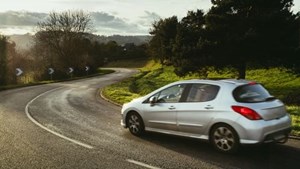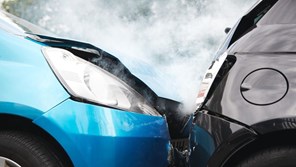How to regain confidence after a minor car accident
7 minute read

Whether you’ve been driving for a short amount of time or have years of driving experience, having a minor car accident can knock your confidence. If you want to get back behind the wheel when the time is right, read on to find out more about regaining your confidence after a car accident, as well as how to deal with anxiety about driving.

Over 50s Car Insurance
Age Co helps drivers stay protected on the road. We’re 100% owned by Age UK and our profits go back to the charity.
How to overcome the fear of driving after a minor accident
If you’ve recently been involved in a car accident and are struggling to get back behind the wheel, try following one or all of the six tips below.
1. Speak to someone
For some people, talking about their issues or concerns is often an important part of the recovery process. Speaking to someone about your accident could be the first step towards getting over the shock and regaining your confidence. It doesn’t matter if you choose to speak to a family member, a friend or a professional – speak to whoever you think is best and someone that you’re comfortable with.
2. Allow yourself to think of the accident
You should allow yourself to think about the accident and maybe even write down some of the details.
By replaying the memories, your mind may begin to become desensitised to the incident and you may find it less upsetting as time goes on. It’s likely that when you make a claim on your car insurance, your provider will ask for these details anyway, so relaying what happened to them could help you too.
In some cases, they may require a diagram to demonstrate how the accident happened. This can all help with the healing process.
3. Take your time
The popular saying “get back on the horse” suggests that you should be back in the saddle immediately after a fall. While this approach may work for some people, it might not work for you. You should take as much time as you need until you feel comfortable getting back in the vehicle, and properly assess whether it’s appropriate or safe for you to continue driving. Ultimately, this decision is up to you and will be different for each person.
4. Start small
If you do make the decision to start driving again, you shouldn’t rush the process. Start by driving a very short distance on roads that you know and are comfortable with. If possible, you should pick a day and time that will be quiet, such as midmorning during the week. Most people will be at work at this time and the roads should be relatively empty. You could take a short journey to the local shops or to visit a family member. To practise driving at night, you could go out around 9pm when the roads are clear.
If the thought of this sounds too much, try being a passenger to begin with. Gradually get used to being back in a car without the added anxiety of having to drive yourself.
5. Progress slowly
You shouldn’t expect to be the same driver that you were before the car accident after a matter of days or weeks. Regaining confidence can take time and you shouldn’t put too much pressure on yourself. Keep driving on a regular basis, taking short journeys to start with and gradually increase the amount of time you’re driving for.
6. Take extra lessons
If you find that you’re still very nervous when in the car, you could try taking some additional lessons. The Pass Plus qualification covers aspects of driving that you don’t learn in standard lessons, such as motorway driving, night-time driving and even navigating country roads. These extra skills could give you some much needed confidence.

How to deal with anxiety while driving
Anyone can feel anxious while driving, whether they’ve had an accident or not. For some, driving doesn’t come very naturally and every journey could make you feel anxious and distressed. Luckily, there are some ways you can overcome this anxiety.
Face your anxiety
Your anxiousness may stem from issues that you had while you were learning to drive. You might avoid using certain manoeuvres, such as parallel parking, or dodge certain roads because they would involve a hill start. It may be that you’ve had a bad experience while attempting these things and haven’t practised them very often since.
As scary as it may be to do these things, the only way to fight the anxiety is to practise them. Have a think about what makes you most anxious when you’re driving and try to do these things more and more.
You may wish to start at a quieter time of day when there is less traffic on the road. Over time, you’ll find that your essential driving skills will have improved and that your anxiety has reduced.
Ensure your car is safe to drive
Some people have driving anxiety because they believe there’s something wrong with their car. How many times have you worried that a tyre doesn’t have enough air or that your vehicle’s brake lights aren’t working? Checking these things before you set off could reduce any worrying during the journey.
Newer car models have built-in sensors that can alert you to such issues, such as if your tyre pressure is too low, you’re running out of screen wash or any bulbs aren’t working. Having these kinds of alerts could make you relax more when you’re on the road.
As well as checking certain safety elements, you should also take the time to adjust your seat and mirrors so that you can see everything around you, as well as feel comfortable and relaxed in your seat.
Drive with a passenger
If you’re a nervous driver, it can help to have another person in the car, particularly when you haven’t driven a car for a long time. They can be an extra pair of eyes, helping you to navigate if you’re unsure of where you’re going, or just someone to talk to and put you at ease.
Avoid distractions
There’s a lot to concentrate on when you’re driving, from where you’re going and traffic lights, to hazards and other drivers. While you’re getting back into the swing of things, try to avoid distractions, such as music.
Drive a bit slower
If you find that your anxiety is creeping up when you’re in the car, it’s important to recognise that you’re anxious and try to calm yourself down.
The first thing to do is slow down. The faster you drive, the more information your brain needs to process about what is happening around you, which could result in further feelings of anxiety. You should take your foot off the accelerator and drive at a slightly slower pace. Do, however, be aware that driving very slowly on fast-paced roads can be dangerous for other drivers around you, so it may be worth avoiding such roads until you feel more confident.
Practise breathing exercises
If your anxiety becomes too much, you should find a safe place to pull over and stop the car. It can be almost impossible to drive carefully when your mind isn’t fully focused on the road. Take some long breaths in and out using the 5-5-5 method - inhale for five seconds, hold it for five seconds and exhale for five seconds. Repeat a few times until your heart rate has slowed down. Only set off when you’re feeling completely calm again and if you need to, contact someone you trust for support.
Though it may not feel like it at the moment, your confidence will begin to slowly return and we hope that the advice laid out above helps with this process.

Sign up to the Age Co Newsletter
Each month, our email newsletter delivers inspiring stories, practical guides to later life, plus the latest news about Age Co and the charitable work we support.
